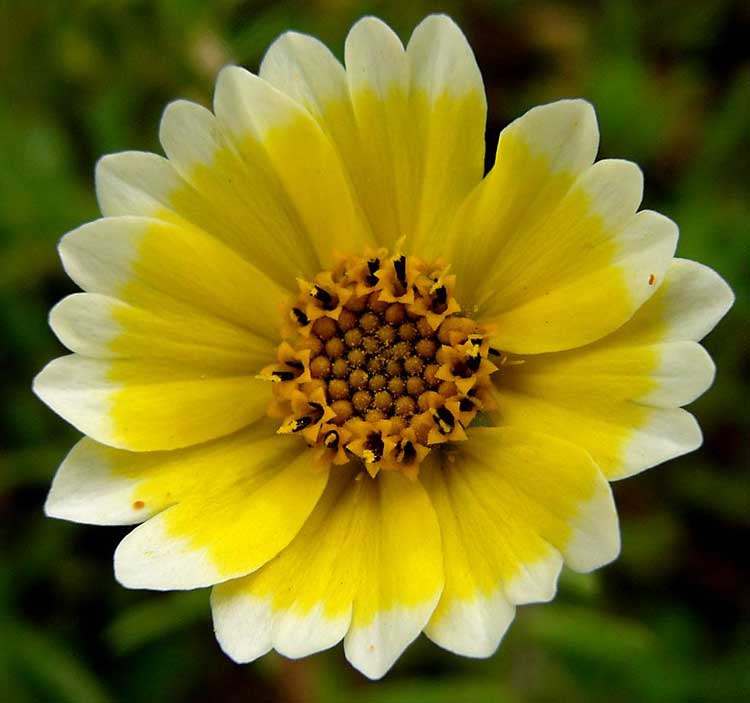
Layia platyglossa, Photo: nps.gov
Classification System: APG IV
Superregnum: Eukaryota
Regnum: Plantae
Cladus: Angiosperms
Cladus: Eudicots
Cladus: Core eudicots
Cladus: Asterids
Cladus: Campanulids
Ordo: Asterales
Familia: Asteraceae
Subfamilia: Asteroideae
Tribus: Madieae
Subtribus: Madiinae
Genus: Layia
Species: Layia platyglossa
Name
Layia platyglossa (Fisch. & C.A.Mey.) A.Gray, Mem. Amer. Acad. Arts ser. 2, 4:103. 1849
Synonyms
Blepharipappus platyglossus (Fisch. & C. A. Mey.) Greene
Callichroa angustifolia (Nutt.) Walp.
Callichroa hirsuta (Nutt.) Walp.
Callichroa platyglossa Fisch. & C. A. Mey.
Layia platyglossa subsp. campestris D.D.Keck
Layia ziegleri Munz
Madaroglossa angustifolia Nutt.
Madaroglossa hirsuta Nutt.
Distribution
Native distribution areas:
Continental: Northern America
Regional: Southwestern USA
USA (California)
Regional: Mexico
Mexico (Baja California Norte)
References: Brummitt, R.K. 2001. TDWG – World Geographical Scheme for Recording Plant Distributions, 2nd Edition
References
A.Gray, Memoirs of the American Academy of Arts and Science, new series 4(1): 103. 1849.
Links
International Plant Names Index. 2018. Layia platyglossa. Published online. Accessed: Feb. 23 2018.
The Plant List 2013. Layia platyglossa in The Plant List Version 1.1. Published on the internet. Accessed: 2018 Feb. 23.
Tropicos.org 2018. Layia platyglossa. Missouri Botanical Garden. Published on the internet. Accessed: 2018 Feb. 23.
Hassler, M. 2018. Layia platyglossa. World Plants: Synonymic Checklists of the Vascular Plants of the World In: Roskovh, Y., Abucay, L., Orrell, T., Nicolson, D., Bailly, N., Kirk, P., Bourgoin, T., DeWalt, R.E., Decock, W., De Wever, A., Nieukerken, E. van, Zarucchi, J. & Penev, L., eds. 2018. Species 2000 & ITIS Catalogue of Life. Published on the internet. Accessed: 2018 Feb. 23. Reference page.
USDA, ARS, Germplasm Resources Information Network. Layia platyglossa in the Germplasm Resources Information Network (GRIN), U.S. Department of Agriculture Agricultural Research Service. Accessed: 07-Oct-06.
Vernacular names
English: coastal tidy tip
suomi: kehrätipsu, tipsu
Layia platyglossa, commonly called coastal tidytips,[1] is an annual wildflower of the family Asteraceae, native to western North America.
Distribution
Tidytips was formerly found throughout low-elevation dry habitats in California including the Mojave Desert and into Arizona and Utah.[1] In pre-European times this plant was common in solid stands at lower elevations. Found in grassy valley floors, slopes of hills, openings in coastal sage scrub and chaparral, coastal plains, and in the High Desert. A member of Spring wildflower 'displays,' blooming March to June.
Description
Layia platyglossa is an annual, glandular, daisy like plant with narrow, rough hairy leaves. The height of the entire plant is less than 1 foot (0.30 m), roughly around 4–12 inches (10–30 cm) wide. The roots are usually taproots, sometimes fibrous.[2][3]
The leaves at the upper part of the stem are short and have a pilous texture. The leaves at the basal part of the stem can be dentate to pinnate shaped with rotund short lobes. The lower leaves are generally lobed and the upper leaves are entire. Leaves usually alternate or opposite, and the blades are usually simple, rarely compound.[2]
Flowers
The plant is an indeterminate zygomorphic inflorescent, individual heads are borne on a peduncle. The stems are usually erect, prostrate or decumbent to ascending, and are stout and corymbed branched.[2]
The flower heads are composed of five to eighteen yellow ray flowers with white tips and many central yellow disk flowers. Its outer ray flowers are bright golden yellow with distinct, sharp-margined white tips. The bracts tips are rounded and involucre 6–12 mm high. The corolla is 4–6 mm long. The ray flowers are 3–3.8 mm long and the disk flowers are 2.8–5 mm long. The ligules are 6–15 mm long and 5–10 mm wide. The florets are bisexual, pistillate, functionally staminate or neuter. The sepals are highly modified.[2]
Pollination is done by insects. The fruits are usually dry with thick, tough pericarps, sometimes rostrate and/or winged. Dispersion is done by the help from pappi (dispersal of fruit by wind). Seeds are one per fruit, embryos straight.[2]
Cultivation
Ornamental
Layia platyglossa is cultivated as an ornamental plant.[4] It is often an ingredient in commercial wildflower seed mixes. The daisy-like flowers are attractive, making it a popular annual flower in traditional gardens, wildlife gardens, and habitat gardens.[5][6]
Restoration
The wildflower is used in habitat restoration projects, and is a pollinator supportive plant. The ripe seeds are a food source for birds.[5]
References
USDA . accessed 11/10/2010
Munz, Philip A.; "Introduction to California Spring Wildflowers of the Foothills, Valleys, and Coast. California" — University of California Press; Berkeley, 2004.
Jepson
Schmidt, Marjorie G.; "Growing California Native Plants" — California: University of California Press Berkeley, 1980.
Lady Bird Johnson Wildflower Center Native Plant Database: Layia platyglossa . accessed 10.1.2013
Las Pilitas Horticultural Database: Layia platyglossa (Tidy Tips) . accessed 10.1.2013
Abrams, Leroy, and Stinchfield, Roxana; "Illustrated Flora of the Pacific States. Vol IV: Bignonias to Sunflowers" — California: Stanford University Press, 1960.
Retrieved from "http://en.wikipedia.org/"
All text is available under the terms of the GNU Free Documentation License

